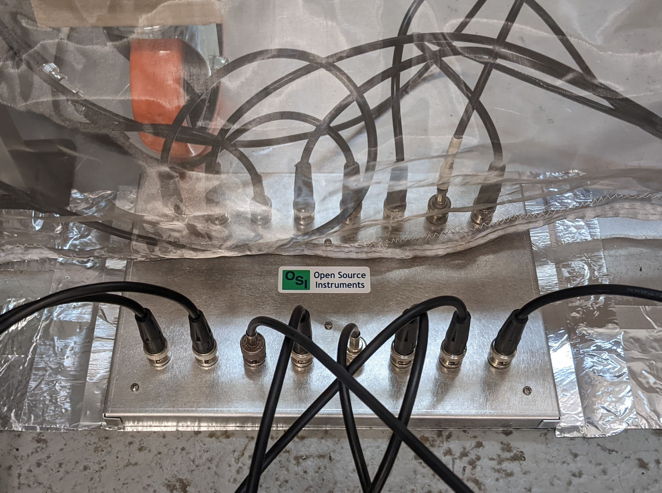
Figure: Coaxial Feedthrough (A3039E). Designed for use with a Faraday canopy such as the FE5A.
[02-JAN-25] The Canopy Feedthrough (A3039) is any one of a family of connector assemblies that carry signals into our Faraday Canopies without compromising the canopy's electrical isolation. Within the canopy, Subcutaneous Transmitters (SCTs) and other telemetry devices can operate without disruption from ambient radio-frequency interference.

If we simply run cables under the canopy without a feedthrough, the cables will pick up ambient interference where they are outside the enclosure, and carry this interference into the enclosure, thus compromising the canopy's electrical isolation, and in extreme cases rendering the canopy ineffective.

We fasten the feedthrough to the aluminum floor that comes with the Faraday canopy and drape the bottom of the canopy itself between the two rows of connectors on the feedthrough assembly. The canopy is made of steel mesh, which makes electrical contact with the top side of the feedthrough. Cables outside the enclosure connect to the cables on the outer side of the feedthrough, and their signals continue on into the enclosure from the connectors on the inside of the enclosure.
The table below lists the deployed versions of the The Canopy Feedthrough (A3039).
| Version | Name | Connector | Positions | Comments |
|---|---|---|---|---|
| A3039E | Coaxial Feedthrough | Coaxial | 8-8 | Vertical BNC sockets, enclosure. |
| A3039F | Ethernet Feedthrough | Ethernet | 8-8 | Vertical PoE RJ-45 sockets, enclosure. |
[27-JUL-22] We fasten the feedthrough to the edge of the aluminum floor of our Faraday canopy with aluminum tape. The tape provides a high-frequency contact between the ground of the feedthrough and the aluminum floor. We make sure the canopy curtain rests upon the top of the feedthrough enclosure. If the feedthrough has no enclosure, we run a piece of aluminum tape along the center-line of the feedthrough so that the curtain will make electrical contact with the tape.

In the photograph above, we see the aluminum sheet floor of the enclosure is taped to the laboratory floor with aluminum tape. The aluminum tape itself is wide, and extends beyond the aluminum sheet by five or ten centimeters. We fasten the feedthrough enclosure so that it lines up with the outer edge of the tape. We secure the enclosure in place by taping its flanges to the floor. The curtain falls naturally between the two sets of cables, where the cables themselves constrain it to lie upon the enclosure, thus grounding the curtain to the enclosure and the floor.
[10-MAR-21] The BP2C+ on the A3039C are at risk of being in electrical contact with both the mesh and applied aluminum tape during installation. We will be covering them in clear DP270 Epoxy in order to insulate them electrically.
[02-JAN-25] For a chronological account of the development of the A3039 feedthroughs, see our separate Development and Production page.